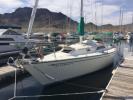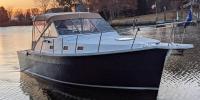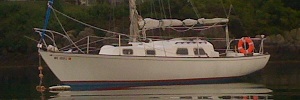|
#1
IP: 142.68.246.133
|
||||
|
||||
|
Image of thermostat housing block side?
I have good photographs of the inside of the upper thermostat housing, but no images of the head side, where the thermostat lives. Can anyone post one? I want to see how the water from the head comes up from the head into the upper housing. Thanks in advance.
(In the image below, I think the bypass hose enters on the left, and the exit to the manifold is on the right.)
__________________
1974 C&C 27 Last edited by rigspelt; 06-29-2010 at 06:12 AM. |
|
#2
IP: 68.224.118.14
|
||||
|
||||
|
Rigs-
Someone else may have a better image than I do, but here goes... The image with the arrows gives you some idea of the "ports" in the housing. I labeled them for orientation since with the closeup views it's hard to tell what you're looking at. You can barely make out the FROM ENGINE hole. (The FROM PUMP and EXIT TO MANIFOLD ports are obviously in the Upper Housing) If someone else doesn't have anything clearer, I'll snap some better ones later this week when I'm playing with my "RED HOT" fuel pump... 
__________________
-Jerry 'Lone Ranger'  1978 RANGER 30 Last edited by roadnsky; 06-29-2010 at 11:24 AM. Reason: Explain the arrows |
| The Following User Says Thank You to roadnsky For This Useful Post: | ||
TimBSmith (08-01-2021) | ||
|
#3
IP: 206.125.176.3
|
||||
|
||||
|
I knew there was really no reason to worry about who would come up with the picture
 
__________________
-Shawn "Holiday" - '89 Alura 35 #109 "Twice Around" - '77 C-30, #511 with original A-4 & MMI manifold - SOLD! (no longer a two boat owner!!) 
|
|
#4
IP: 68.224.118.14
|
||||
|
||||
|
Well, I did wait as long as I could...

__________________
-Jerry 'Lone Ranger'  1978 RANGER 30 |
| The Following User Says Thank You to roadnsky For This Useful Post: | ||
TimBSmith (08-01-2021) | ||
|
#5
IP: 193.253.220.149
|
||||
|
||||
|
Nice picture...just a question about the arrows. Would the "from engine" not be a "to engine"? I always assumed that with constant pressure coming from the pump, the flow was always "out" of the thermostat housing, either toward the bypass or through the engine (or both). Am I wrong?
__________________
Kelly 1964 Cheoy Lee Bermuda Ketch, Wind and Atomic powered 
|
|
#6
IP: 193.253.220.149
|
||||
|
||||
|
I think I see it now. The diversion takes place at the "T" fitting on the water jacket side plate (engine or bypass). The thermostat housing is a collector, sending all the fluid on to the manifold regardless of origin.
Is that it?
__________________
Kelly 1964 Cheoy Lee Bermuda Ketch, Wind and Atomic powered 
|
|
#7
IP: 142.68.243.199
|
||||
|
||||
|
Quote:
When the bypass valve is open the answer is easy: in a cold engine the thermostat is closed down and more water makes its way through the bypass hose than through the engine block. As the engine and thermostat warm, the thermostat lifts up, allowing more water to flow through the block preferentially. The question for me is when the engine and thermostat are cold and the bypass valve is shut off, does pressure from the water pump lift the thermostat a little bit, or can a normal water pump not overcome the thermostat spring? In that case, it seems to me that the vanes would have to bend a bit against the back pressure so that the water pump's output decreases?? Note there is a hole in the thermostat which must allow just enough water through when the engine is cold to permit some circulation through the block. Very clever engineering. The picture here of the early market thermostat shows that hole plainly. I presume there is one in the single action aftermarket thermostat, but don't have one to look. I borrowed these images from MMI's online catalogue. --- Mr. Hess left this note in his FAQ at http://www.cncphotoalbum.com/atomic4/faq/atomic4faq.htm: "The large single spring fitted to the new Atomic Four thermostat supplied by Westerbeke has less pressure than the 3 small springs used on the OEM Holley thermostat originally fitted on engines made after 1968. If there is any restriction in the bypass line and/or a higher pressure Oberdorfer M7 (full cam) water pump has been fitted, the pressure developed by the water pump will actually overcome the force of the spring and open the thermostat slightly when the engine is cold. This can cause the engine to take longer than usual to warm up to operating temperature, as well as causing engines being operated in very cold water to run colder than the rated thermostat temperature." --- Don wrote this at http://www.moyermarine.com//forums/s...ead.php?t=3893: "By way of background, the original late model factory solution was to use double-action thermostats which start to open and allow some coolant through the block and head as engine temperature moves past 140 degrees, and they then close off the bypass port in the thermostat housing when the engine temperature reaches 180 degrees. In standard late model bypass systems, engine temperature is free to vary between 140 and 180 degrees, depending primarily on the condition of the cooling jackets, temperature of raw water, and the load imposed on the engine. Double-action O.E.M. thermostats have become very expensive, and (although still listed in our online catalog) are becoming problematic to keep in stock. We eventually joined others several years ago in offering an aftermarket thermostat that functioned like the O.E.M unit until the source of those thermostats disappeared in the past several months as well. At that time we concluded that the most cost effective and reliable solution was to incorporate a single-action thermostat into our kits, using a separate method of regulating the bypass loop. The separate method of providing a bypass restriction for single-action thermostats (to finally answer your question) is because they have no ability to regulate the bypass loop as temperature increases past 180 degrees. On our test stand, a spring loaded check valve providing 2 to 3 psi backpressure maintained normal temperature in a raw water cooled configuration using the single-action thermostat provided in our kits (CSTH_01_510). In freshwater cooled engines it’s frequently necessary to fully close the bypass loop when operating at high power settings in warm climates so a manual ball valve is recommended in those cases as well. In an effort to cover both applications, we currently provide a spring loaded check valve and a small manual ball valve in our by-pass restriction kits (product number CSOT_01_61). It should be noted that the need to provide a restriction of some kind in the bypass loop is not limited to the single-action concept. Universal themselves realized that unless their bypass type system had a restriction in the bypass loop, many engines would operate hotter than desired. In a technical bulletin from the mid-seventies, they recommended that the 90 degree elbow in the inlet to the thermostat housing be filled with lead and then re-opened by drilling an 1/8” hole in the lead. That technical bulletin was largely ignored in favor of more practical solutions and many Atomic 4s today are already equipped with either a manual ball valve or a spring loaded check valve in the bypass loop." --- Don wrote this at http://www.moyermarine.com//forums/s...ad.php?p=10659: "In actual practice, thermostats don't ever seem to completely block off the flow of coolant through the block and head. In the case of OEM thermostats, they simply don't close that tightly, and in the case of our MMI aftermarket thermostat kits (which do close more tightly), the thermostats have a small bleed hole in the movable valve assembly. In the case of FWC engines, this leakage through even normally functioning thermostats sometimes makes it necessary to artificially close off the bypass hose completely during hot times of the year and at high power settings to provide maximum cooling. For this reason, we have gone to installing small ball valves in the bypass loops on all our exchange engines. You can see these valves in the new 360 view of an exchange engine by clicking "here" next to the "new star" on our home page. If you rotate the engine one click to the right, you can see the whole bypass loop configuration. " --- Another take on A4 temperature regulation at the Indigo site: http://www.atomic4.com/TMV.html. --- Images from MMI's online catalogue: Left: early model thermostat. Right: aftermarket single action thermostat.
__________________
1974 C&C 27 Last edited by rigspelt; 06-30-2010 at 06:07 AM. |
| The Following User Says Thank You to rigspelt For This Useful Post: | ||
TimBSmith (08-01-2021) | ||
|
#8
IP: 142.68.243.199
|
||||
|
||||
|
Now I'm looking for an image showing a correctly installed thermostat in the lower housing. I found this one online: http://weliveonaboat.com/uploaded_im...009-719590.jpg.
__________________
1974 C&C 27 |
|
#9
IP: 142.68.252.45
|
||||
|
||||
|
Got some pics at a friend's place. Just wanted to complete the pictures to show orientation. Notice the small bleed hole in the small plate that rises up against the housing boss to block the bypass flow. This thermostat housing has the spacer modification. The engine was in a shop getting a refit, complete with a new coat of paint.
__________________
1974 C&C 27 Last edited by rigspelt; 07-31-2010 at 11:09 AM. |
|
#10
IP: 50.72.246.102
|
|||
|
|||
|
Holley 3 spring Thermostat
Hi Gentlmen
The pictures are perfect for answering my question. I am a total newbie when it comes to mechanical knowledge and I am embarrassed to ask questions when I know in hindsight I should have made notes or taken a picture. So, please bear with me for asking the following "foolish" question: I took out my Holley thermostat out of my 1979 Atomic 4 engine last fall. I forgot to observe if the pointed end was up or down in the thermostat housing. I assume from the pictures that the water comes from the pump into the thermostat housing and into the head where it then goes out the manifold area. My engine is FWC'd and I do not have any aftermarket stuff like a heat exchanger. My question is: Does the pointed end of the Holley Tstat point down into the head or block? Thanks for any advice you can give me. |
|
#11
IP: 107.0.6.150
|
||||
|
||||
|
Post #9 shows the thermostat correctly installed in the picture on the left. (spring down)
|
|
#12
IP: 161.213.49.150
|
|||
|
|||
|
Don't be afraid to ask questions. This is a safe place. Belittling others for things they haven't learned yet in life is not tolerated around here.
I'm not going to answer your thermostat orientation question directly. Do you know how a two stage theromstat works? When the theromstat opens it blocks the flow from the bypass which forces the flow to go through the engine. Be sure to check the thermostat housing. Why did you remove the thermostat? Engine running hot? TRUE GRIT Last edited by JOHN COOKSON; 05-12-2015 at 01:52 AM. |
|
#13
IP: 24.152.132.65
|
||||
|
||||
|
Springs down, no pointed end on the Holley, it has a mushroom top that applies variable restriction to the bypass port.
__________________
Neil 1977 Catalina 30 San Pedro, California prior boats 1987 Westsail 32, 1970 Catalina 22 Had my hands in a few others Last edited by ndutton; 05-11-2015 at 07:19 PM. |
|
#14
IP: 108.45.83.193
|
||||
|
||||
|
Quote:
The coolant from the pump enters the engine block at the side plate after splitting off some of the flow through a tee. The coolant in the block circulates up through the head and exits the head via the thermostat, through the thermostat housing, and into the manifold. The other end of the aforementioned tee is called the bypass, and allows some coolant to bypass the block and head, and is injected directly into the top of the thermostat housing. I'm guessing you meant RWC (Raw Water Cooled), not FWC (Fresh Water Cooled, as FWC systems always have a heat exchanger.
__________________
@(^.^)@ Ed 1977 Pearson P-323 "Dolce Vita" with rebuilt Atomic-4 
|
|
#15
IP: 50.72.246.102
|
|||
|
|||
|
Thanks for the responses. Yes, to Ed, I meant RWC, not FWC. I should know (and actually do know) that sailing my boat in a lake (Fresh Water) does not mean my boat is FWC'd. I find as I get older, I am having more and more senior's moment.
Ed, regarding your comments about the route that water takes in an Atomic 4, I have been looking for pictures of an Atomic 4 so that I can trace the path that the raw water takes as it finds its way through the block, to the Tstat, rejoins and goes into and out of the manifold and thus back into the lake but I haven't found any yet. In response to the question from John Cookson as to why I removed my thermostat, I should explain that I was winterizing my boat on my own last fall for the first time rather than having done by a local business. I did this not so much to save money but more in order to get to know my engine better etc. My boat was on the hard in the fall and so rather than run the engine (and damage it by overheating) I removed the thermostat to ensure that when I flushed the RV antifreeze through the engine (block?), that the antifreeze would also go through the area where the thermostat is located. My engine has never run hot, always around 160 F. Now that I know how to position the Tstat correctly, I should add that I have another question, I can't find a thermostat locally. Is it okay to use the “Water Pump & Thermostat Housing RTV” Gasket Maker by Permatex as a substitute for a gasket instead of using a regular thermostat gasket? Last fall, I had posted some questions about winterizing. BTW, I want to acknowledge all the excellent advice I received last fall when I asked for help in winterizing my Atomic 4 for the brutally cold Manitoba winters. The detailed advice from “Ed” “edwardc” and from some of the other Afourians was much appreciated. I am now back with some more questions. In a different thread, I noticed pictures posted by Raymond which showed the Tstat housing and Tstat very badly corroded. My case is much the same. As advised by Ed in that thread, I soaked my Holley Tstat in vinegar overnight and scrubbed it with a toothbrush. I did the same with my Tstat housing. I read the suggestions by “nnstanley” and my questions are as follows: 1.Do I soak the Tstat housing in full strength muriatic acid?; 2.In order to flush the water jacket with full strength muriatic acid, do I by just pour it into the head of the engine and then start the engine?; 3.Do I follow the same procedure with the vinegar flushes. I would appreciate hearing responses to my questions. Thanks for any advice you can provide I must add to this thread that I am very impressed not just with the knowledge of the many persons who provide detailed advice but also with the amount of time that is obviously being taken to read the posts, analyze the problem, critique and evaluate the answers given by various MVP Afourians and others and then provide advice that responds to the questions asked. However, there is downside too, in that with my having a steep learning curve because of my lack of knowledge in mechanical and electrical matters (especially engines) there is so much information about Atomic 4 issues and other matters that I find it all a bit overwhelming, sort of like overload in high school when I had to memorize math formulas etc. However, the info on the Moyer Marine web page and all the forums is absolutely outstanding and very much appreciated. I thank all of you for your anticipated help to my 4 questions. |
|
#16
IP: 76.179.157.47
|
||||
|
||||
|
Beyent: if you don't have one already (and I'm thinking you do not), purchase The Manual from our Forum host MMI. I cannot stress this strongly enough. It is clearly written, well illustrated, and will answer many of your questions. Good for you to learn a new set of skills - I was in the same position not too many years ago.
Do this now, and buy a couple gaskets to slip in with the shipping....  I've only ever tried a gasket goop to make valve cover gaskets, where there's basically no pressure, and no fluid. It leaked. Granted, it was an American Motors product.... Others may have better experience, but there's a reason they make gaskets. Hit your friendly local auto parts store, and buy a sheet of gasket material. Use the housing for a pattern and an exacto knife. Or spend the $3 and wait for your manual to arrive.... DO NOT play around with full strength muriatic acid. Yet. DO NOT play indoors with it either. It fumes and can seriously hurt you - lungs or skin. I emphasize this because your questions are a bit alarming - maybe you know this already. There are a number of threads on here about flushing.... Search 'vinegar flush'... It's also fully described in the manual. Fully explore vinegar flushing before you attempt muriatic acid. It's a similar technique, without the risk of serious chemical burns. Why do you want to flush? You were running ok at 160.... You can clean out the housing with a wire brush. PS: Welcome to the Forum!
__________________
Jeff  S/V Bunny Planet 1971 Bristol 29 #169 Last edited by BunnyPlanet169; 05-13-2015 at 09:33 PM. |
|
#17
IP: 107.0.6.242
|
||||
|
||||
|
+1 on the dangers of muriatic acid. Whenever I work with it I always make sure I remain upwind of it in a well ventilated area. Even the fumes in small quantity can hurt your eyes and lungs. Be careful.
|
|
#18
IP: 108.48.208.185
|
||||
|
||||
|
Beyent...Welcome to the forum...and I second the MMI manual if you don't have one.
 What were the results when you tried full strength VINEGAR on the t-stat?? You've already got lots of info on muratic acid..it is one of those things you definitely wear safety glasses for and use gloves and long sleeves. Even a splash of the acid while pouring into a bucket of water can hassle your skin. Did we answer all the questions ?
__________________
-Shawn "Holiday" - '89 Alura 35 #109 "Twice Around" - '77 C-30, #511 with original A-4 & MMI manifold - SOLD! (no longer a two boat owner!!) 
Last edited by sastanley; 05-13-2015 at 10:42 PM. |
|
#19
IP: 108.45.83.193
|
||||
|
||||
|
Quote:
Quote:
http://www.moyermarine.com/cgi-bin/s...rebuilder.html
__________________
@(^.^)@ Ed 1977 Pearson P-323 "Dolce Vita" with rebuilt Atomic-4 
|
|
#20
IP: 50.72.246.102
|
|||
|
|||
|
Tstat etc
Thank-you for all the advice from each of you. All my questions and concerns (re the muriatic acid) have been answered. Thank-you for reinforcing my concerns about muriatic acid.
To respond to the questions asked in some of the posts, the vinegar soak of my Holley Tstat and of the Tstat housing did wonders. All the grime and rust is gone and I can now read the name of the manufacturer and state of manufacture of the Holley Tstat. My boat is going in on May 20 (May 18th is a national holiday) so I don't have the time to wait for the gasket. I will pick up some gasket material at a NAPA store in the meantime and yes, it makes sense to order the gasket when I order the Manual. Thanks again for all the help. |
|
#21
IP: 50.72.246.102
|
|||
|
|||
|
Vinegar flushes
One last question. I'll leave the muriatic acid out of the picture for now. If I use vinegar to flush, do I pour it into the head opening where the Tstat is located or do I pump it through the entire engine block.
Ed, the diagram you posted re water movement in the engine is excellent. Thanks. |
|
#22
IP: 24.152.132.65
|
||||
|
||||
|
No, it is typically pumped through using the engine coolant pump. The thermostat should be removed but the housing reinstalled for this procedure. Close the bypass valve too - or if one is not fitted, pinch the bypass hose with vise grips.
__________________
Neil 1977 Catalina 30 San Pedro, California prior boats 1987 Westsail 32, 1970 Catalina 22 Had my hands in a few others |
|
#23
IP: 45.148.7.5
|
|||
|
|||
|
I am planning to do the vinegar flush too, but Neil, why do you suggest to remove the Tstat? My plan was to get the engine hot then switch the hose from the thruhull to the vinegar (5% acetic acid) , while pinching the bypass hose (as you suggest). Then stop engine and let sit a few days. Repeat.
Would this method get vinegar throughout the block and exhaust? Thanks DonC |
|
#24
IP: 104.174.83.118
|
||||
|
||||
|
Quote:
Quote:
__________________
Neil 1977 Catalina 30 San Pedro, California prior boats 1987 Westsail 32, 1970 Catalina 22 Had my hands in a few others |
| The Following User Says Thank You to ndutton For This Useful Post: | ||
campbdon (08-01-2021) | ||
|
#25
IP: 47.142.129.3
|
|||
|
|||
|
HERE'S WHAT I DO
Mix water and muriatic acid* in a five gallon bucket.
Put the water pump inlet hose into another five gallon bucket full of water from the marina water supply. Start the engine and run it until it gets to operating temperature. Supply water to the bucket as needed. The thermostat will be open when the engine gets to operating temperature. Idle the engine back and close the valve on the bypass forcing all the cooling water through the thermostat. Put the inlet hose into the bucket of diluted acid. After the acid is aspirated turn the engine off for 15 or so minutes. Then place the inlet hose back into the bucket of water, start the engine, and flush the acid out. *I like muriatic acid because it's done and over quickly - you don't have to come back later to complete the job. ex TRUE GRIT Last edited by JOHN COOKSON; 08-02-2021 at 06:26 PM. |
| The Following User Says Thank You to JOHN COOKSON For This Useful Post: | ||
TimBSmith (08-02-2021) | ||
 |
| Thread Tools | |
| Display Modes | |
|
|
 Similar Threads
Similar Threads
|
||||
| Thread | Thread Starter | Forum | Replies | Last Post |
| I love this forum...rubber in the 90 degree fitting | RobH2 | Cooling System | 221 | 08-01-2010 12:26 PM |
| Exhaust leak in cooling system, power loss? | fvigeant | Cooling System | 46 | 06-28-2010 09:00 PM |
| Thermostat Housing Roof Too Low??? | Dana Paterson | Cooling System | 0 | 09-27-2007 10:32 PM |
| Thermostat Housing Fused to Block | daveinrenton | Cooling System | 3 | 05-01-2006 02:04 PM |
| New Products From Moyer Marine | Don Moyer | Cooling System | 0 | 10-05-2005 02:03 PM |